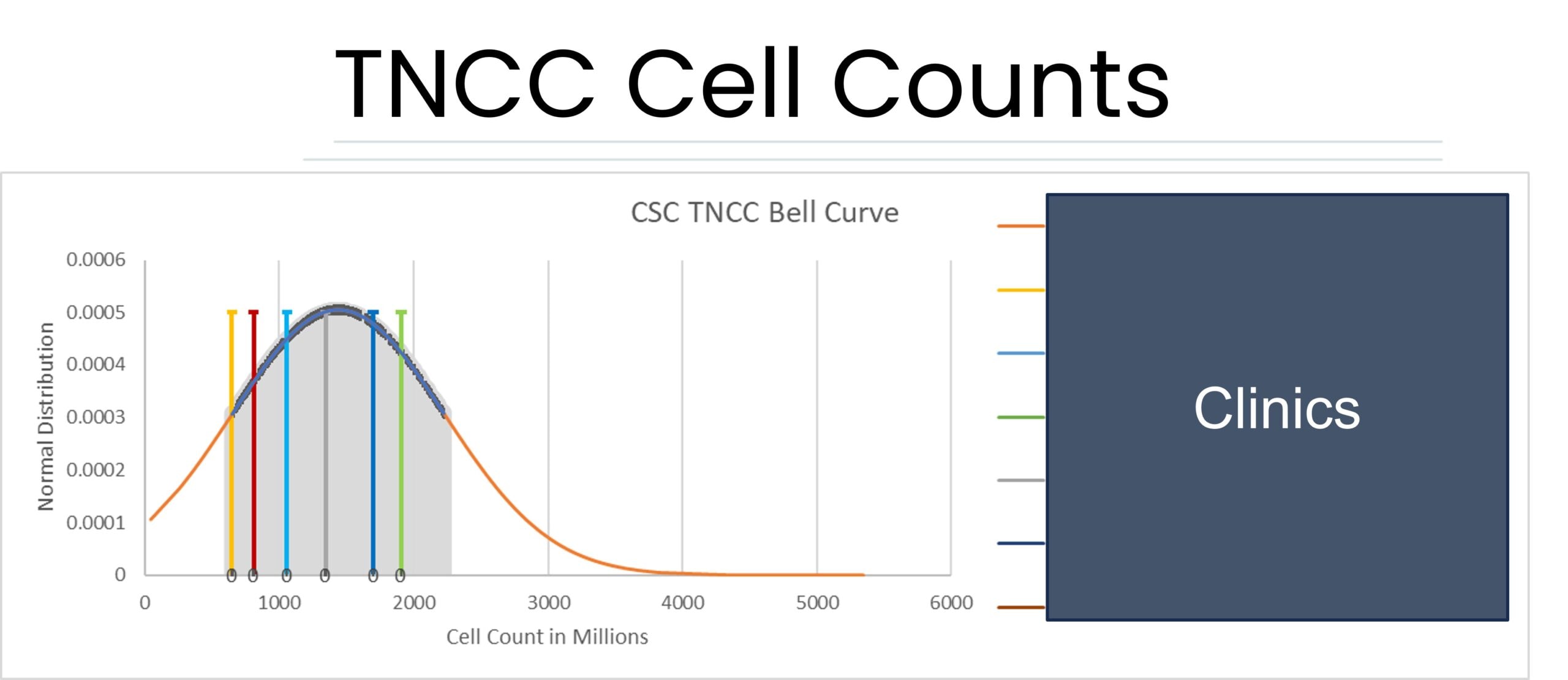Making Sure Orthobiologic Procedure Standards Don’t Slip

As consumers, it’s not hard to look at everyday items and determine their quality relative to their price. It’s also easy to see if you’re getting the same product at a Starbucks in the Seattle airport or the one in the Miami airport. However, with orthobiologics, these quality metrics are hard for a patient to quantify. Let me take you through a single one of many QA processes at Regenexx so you can understand how we ensure uniformly high-quality procedures.
Cell Dose
We know through several studies that the cell dose of a bone marrow concentrate procedure containing the patient’s own stem cells is important in determining the outcome of that procedure (1-4). Our research group has published two of those four studies that show that more cells means a greater likelihood of a successful procedure. However, there’s a problem hidden from patients that can wreck the probability of maximizing that outcome. That invisible issue is based on cutting corners to save time.
Any BMC procedure begins with a Bone Marrow Aspiration (BMA). A high-quality BMA takes small aliquots of aspirate from many areas, which maximizes the number of stem cells harvested. However, this takes more time for the doctor. Hence, to save time, physicians often shortcut this step and draw as much aspirate from a single spot as possible. Regrettably, we know that this reduces the number of stem cells (5-7).
So is your doctor cutting corners? How would you know?
Regenexx QA on BMA Quality
While every Regenexx site is trained to do the more time-consuming and higher stem cell yield BMA, how can we ensure that every clinical site on our network is doing that and not letting the standards slip? That can be done by comparing their mean TNCC counts. Let’s dig in there a bit.
Measuring Mean Cell Counts Across Clinical Sites

Above you see a normal distribution bell curve with one standard deviation from the mean in grey. The numbers and colored vertical lines are the mean Total Nucleated Cell Counts (TNCC) of various Regenexx network clinics. This is the total cell content in their final product BMC (Bone Marrow Concentrate). The distribution was created using our Regenexx HQ site in Colorado’s TNCC values.
As shown above, this TNCC count is higher when the doctor isn’t cutting corners on the BMA draw. When a clinic falls outside of this curve, we know something may be up. That could mean that they are taking shortcuts on the BMA as described or aren’t counting properly. Or it could indicate a problem is processing the BMA to create BMC. Regardless, knowing these values and comparing them to a known high-quality mean lets us fix quality issues.
Counting Cells
No matter where you decide to get an orthobiologics procedure, you can’t do quality checks like this unless you count the cells in the bone marrow. What percentage of clinics do this? Less than 1%. That means that 99% of the clinics performing these procedures have no clue about the clinical dose that’s being injected. In no other area of medicine is not knowing the dose of a substance injected into the body permitted. That gives you some idea of how “wild” the stem cell wild west is currently.
Why Do Any of This?
This all takes time and resources. For example, our lab QA team put this graph together. In addition, patients would have no idea if this were a problem, as details like this are largely invisible to them. However, as an inventor of this space and pioneer, I know when stuff like this is happening, and I love Starbucks. What does coffee have to do with it?
That Starbucks matcha latte or macchiato you get in one state is exactly like the one you get in another. In fact, that consistency causes me to seek out a Starbucks wherever I go. That’s the model for the Regenexx network. In a world where the quality of orthobiologics procedures varies wildly between clinic A and clinic B, for Regenexx, the quality must be the same or as close as possible as you accomplish in medicine.
Hence, while you as a patient may never know that some clinic on our network is cutting corners in how a BMA is done, as Chief Medical Officer, I will know. We do this with many things, including clinical outcomes in the world’s largest and oldest orthobiologics registry.
The upshot? As I always say, it’s the wild west out there. However, at Regenexx, we’re constantly thinking of ways to ensure that what you get is what you pay for and that a procedure in Clinic A is the same quality as Clinic B. Given that nobody else on earth is doing this, I hope you see the value and give thanks to the lab team that took the time to put this data together!
___________________________________________________
References:
(1) Centeno CJ, Berger DR, Money BT, Dodson E, Urbanek CW, Steinmetz NJ. Percutaneous autologous bone marrow concentrate for knee osteoarthritis: patient-reported outcomes and progenitor cell content. Int Orthop. 2022 Aug 6. doi: 10.1007/s00264-022-05524-9. Epub ahead of print. PMID: 35932306.
(2) Pettine KA, Murphy MB, Suzuki RK, Sand TT. Percutaneous injection of autologous bone marrow concentrate cells significantly reduces lumbar discogenic pain through 12 months. Stem Cells. 2015 Jan;33(1):146-56. doi: 10.1002/stem.1845. PMID: 25187512.
(3) Hernigou P, Beaujean F. Treatment of osteonecrosis with autologous bone marrow grafting. Clin Orthop Relat Res. 2002 Dec;(405):14-23. doi: 10.1097/00003086-200212000-00003. PMID: 12461352.
(4) Centeno CJ, Al-Sayegh H, Bashir J, Goodyear S, Freeman MD. A dose response analysis of a specific bone marrow concentrate treatment protocol for knee osteoarthritis. BMC Musculoskelet Disord. 2015 Sep 18;16:258. doi: 10.1186/s12891-015-0714-z. PMID: 26385099; PMCID: PMC4575428.
(5) Batinić D, Marusić M, Pavletić Z, Bogdanić V, Uzarević B, Nemet D, Labar B. Relationship between differing volumes of bone marrow aspirates and their cellular composition. Bone Marrow Transplant. 1990 Aug;6(2):103-7. PMID: 2207448.
(6) Muschler GF, Boehm C, Easley K. Aspiration to obtain osteoblast progenitor cells from human bone marrow: the influence of aspiration volume. J Bone Joint Surg Am. 1997 Nov;79(11):1699-709. doi: 10.2106/00004623-199711000-00012. Erratum in: J Bone Joint Surg Am 1998 Feb;80(2):302. PMID: 9384430.
(7) Fennema EM, Renard AJ, Leusink A, van Blitterswijk CA, de Boer J. The effect of bone marrow aspiration strategy on the yield and quality of human mesenchymal stem cells. Acta Orthop. 2009 Oct;80(5):618-21. doi: 10.3109/17453670903278241. PMID: 19916699; PMCID: PMC2823327.

NOTE: This blog post provides general information to help the reader better understand regenerative medicine, musculoskeletal health, and related subjects. All content provided in this blog, website, or any linked materials, including text, graphics, images, patient profiles, outcomes, and information, are not intended and should not be considered or used as a substitute for medical advice, diagnosis, or treatment. Please always consult with a professional and certified healthcare provider to discuss if a treatment is right for you.
